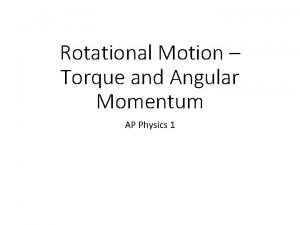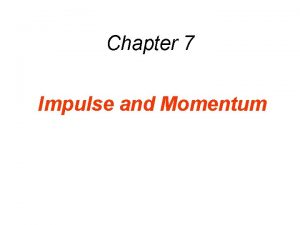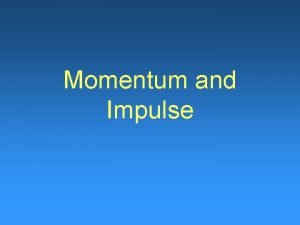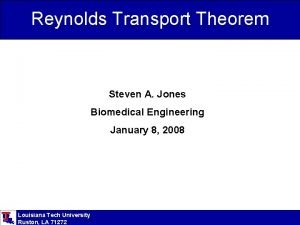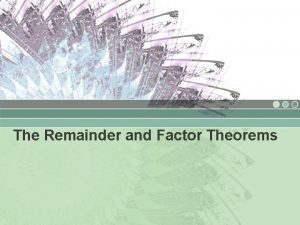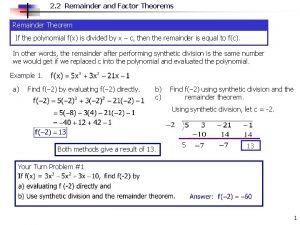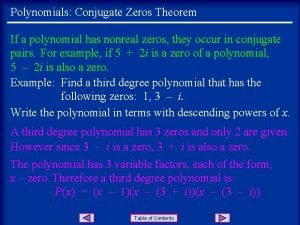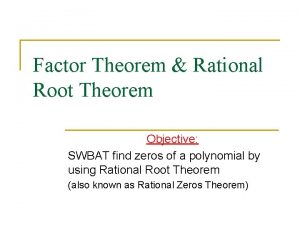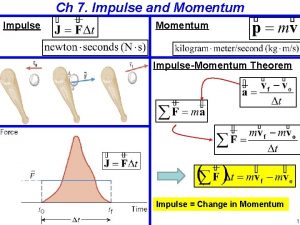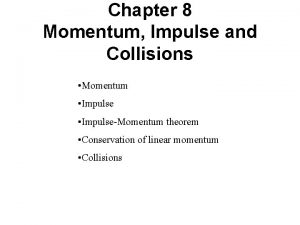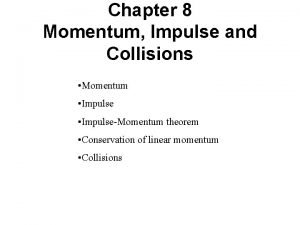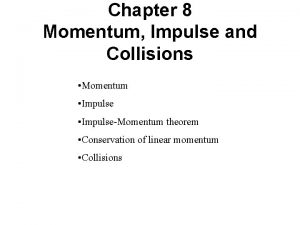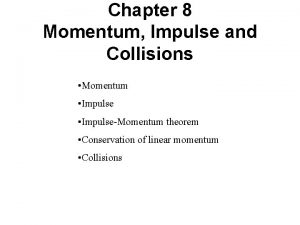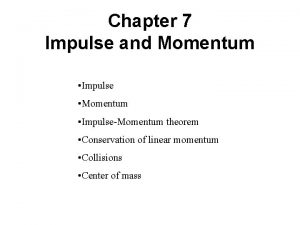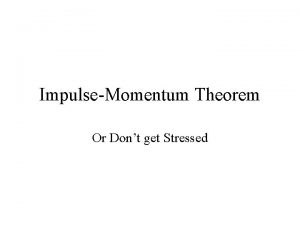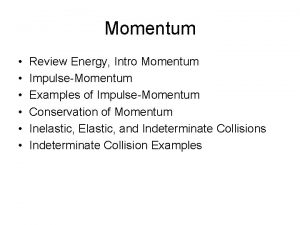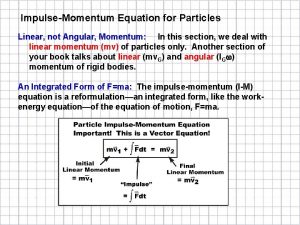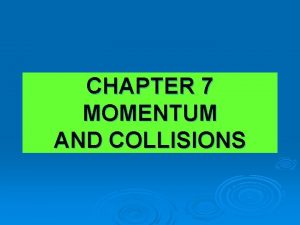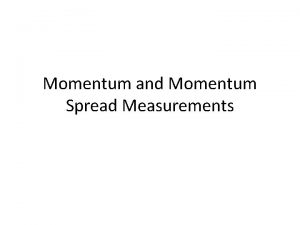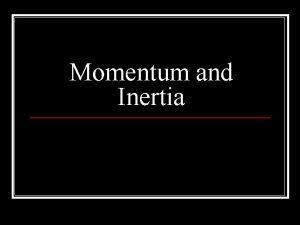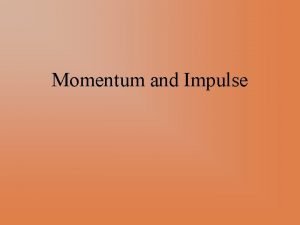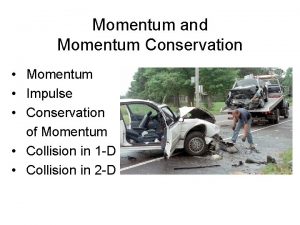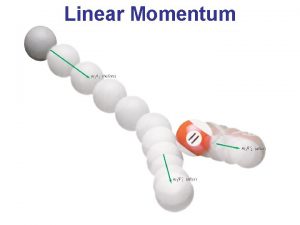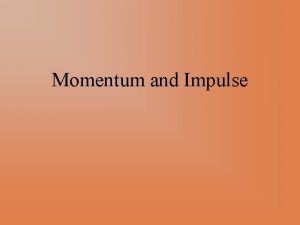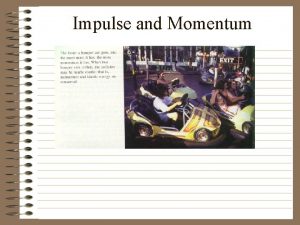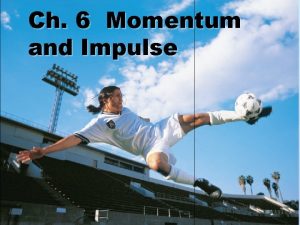Section 9 2 Momentum and the ImpulseMomentum Theorem
































- Slides: 32

Section 9. 2 Momentum and the Impulse-Momentum Theorem (cont. ) © 2015 Pearson Education, Inc.

Bringing and Object to Rest • An object at rest has zero momentum (since its velocity is zero). • Assuming we want to bring an object to rest by applying a force F for some time Δt, what is the relationship between these two quantities? • e. g. if we wanted to stop the object in half the time, how would we need to change the applied force? © 2015 Pearson Education, Inc. Slide 9 -2

Bringing and Object to Rest • The impulse-momentum theorem tells us • The average force needed to stop an object is inversely proportional to the duration of the collision. • If the duration of the collision can be increased, the force of the impact will be decreased, and vice versa. © 2015 Pearson Education, Inc. Slide 9 -3

Quick. Check 9. 6 • Two 1. 0 kg stationary cue balls are struck by cue sticks. The cues exert the forces shown. Which ball has the greater final speed? A. Ball 1 B. Ball 2 C. Both balls have the same final speed. © 2015 Pearson Education, Inc. Slide 9 -4

Quick. Check 9. 6 • Two 1. 0 kg stationary cue balls are struck by cue sticks. The cues exert the forces shown. Which ball has the greater final speed? A. Ball 1 B. Ball 2 C. Both balls have the same final speed. © 2015 Pearson Education, Inc. Slide 9 -5

The Impulse-Momentum Theorem • The spines of a hedgehog obviously help protect it from predators. But they serve another function as well. If a hedgehog falls from a tree—a not uncommon occurrence—it simply rolls itself into a ball before it lands. Its thick spines then cushion the blow by increasing the time it takes for the animal to come to rest. Indeed, hedgehogs have been observed to fall out of trees on purpose to get to the ground! © 2015 Pearson Education, Inc. Slide 9 -6

Example Problem A 0. 5 kg hockey puck slides to the right at 10 m/s. It is hit to the right with a hockey stick that exerts the force shown. What is its approximate final speed? © 2015 Pearson Education, Inc. Slide 9 -7

Quick. Check 9. 5 • A light plastic cart and a heavy steel cart are both pushed with the same force for 1. 0 s, starting from rest. After the force is removed, the momentum of the light plastic cart is ____ that of the heavy steel cart. A. B. C. D. Greater than Equal to Less than Can’t say. It depends on how big the force is. © 2015 Pearson Education, Inc. Slide 9 -8

Quick. Check 9. 5 • A light plastic cart and a heavy steel cart are both pushed with the same force for 1. 0 s, starting from rest. After the force is removed, the momentum of the light plastic cart is ____ that of the heavy steel cart. A. B. C. D. Greater than Same force, same time same impulse Equal to Same impulse same change of momentum Less than Can’t say. It depends on how big the force is. © 2015 Pearson Education, Inc. Slide 9 -9

Try It Yourself: Water Balloon Catch If you’ve ever tried to catch a water balloon, you may have learned the hard way not to catch it with your arms rigidly extended. The brief collision time implies a large, balloonbursting force. A better way to catch a water balloon is to pull your arms in toward your body as you catch it, lengthening the collision time and hence reducing the force on the balloon. © 2015 Pearson Education, Inc. Slide 9 -10

The Impulse-Momentum Theorem Text: p. 259 © 2015 Pearson Education, Inc. Slide 9 -11

Total Momentum • If there is a system of particles moving, then the system as a whole has an overall momentum. • The total momentum of a system of particles is the vector sum of the momenta of the individual particles: © 2015 Pearson Education, Inc. Slide 9 -12

Section 9. 3 Solving Impulse and Momentum Problems © 2015 Pearson Education, Inc.

Solving Impulse and Momentum Problems Text: p. 260 © 2015 Pearson Education, Inc. Slide 9 -14

Example 9. 3 Force in hitting a baseball A 150 g baseball is thrown with a speed of 20. m/s. It is hit straight back toward the pitcher at a speed of 40. m/s. The impulsive force of the bat on the ball has the shape shown in the figure to the right. a. What is the maximum force Fmax that the bat exerts on the ball? b. What is the average force that the bat exerts on the ball? © 2015 Pearson Education, Inc. Slide 9 -15

Example 9. 3 Force in hitting a baseball (cont. ) We can model the interaction as a collision. To the right is a before-and-after visual overview. Because Fx is positive (to the right), we know the ball was initially moving toward the left and is hit back toward the right. Thus we converted the statements about speeds into information about velocities, with (vx)i negative. PREPARE © 2015 Pearson Education, Inc. Slide 9 -16

Example 9. 3 Force in hitting a baseball (cont. ) We want to use the impulse-momentum theorem: SOLVE We know the velocities before and after the collision, so we can find the change in the ball’s momentum: the area under the Force curve is © 2015 Pearson Education, Inc. Slide 9 -17

Example 9. 3 Force in hitting a baseball (cont. ) By the impulse-momentum theorem, ∆px = Jx, so we have Thus the maximum force is Then the average force, is given by Fmax is a large force, but quite typical of the impulsive forces during collisions. ASSESS © 2015 Pearson Education, Inc. Slide 9 -18

The Impulse Approximation • The impulse approximation states that we can ignore the small forces that act during the brief time of the impulsive force. • We consider only the momenta and velocities immediately before and immediately after the collisions. • So we ignore the weight of the objects, air resistance, etc. , when analyzing collisions © 2015 Pearson Education, Inc. Slide 9 -19

Quick. Check 9. 1 The cart’s change of momentum px is A. B. C. D. E. – 20 kg m/s – 10 kg m/s 30 kg m/s © 2015 Pearson Education, Inc. Slide 9 -20

Quick. Check 9. 1 The cart’s change of momentum px is A. B. C. D. E. – 20 kg m/s – 10 kg m/s 30 kg m/s px = 10 kg m/s ( 20 kg m/s) = 30 kg m/s Negative initial momentum because motion is to the left and vx < 0. © 2015 Pearson Education, Inc. Slide 9 -21

Example Problem A 500. kg rocket sled is coasting at 20. m/s. It then turns on its rocket engines for 5. 0 s, with a thrust of 1000. N. What is its final speed? © 2015 Pearson Education, Inc. Slide 9 -22

Section 9. 4 Conservation of Momentum © 2015 Pearson Education, Inc.

Conservation of Momentum • The forces acting on two balls during a collision form an action/reaction pair. They have equal magnitude but opposite directions (Newton’s third law). • If the momentum of ball 1 increases, the momentum of ball 2 will decrease by the same amount. © 2015 Pearson Education, Inc. Slide 9 -24

Law of Conservation of Momentum • There is no change in the total momentum of the system no matter how complicated the forces are between the objects, or how many objects there are. • The total momentum of the system is always conserved if there are no outside forces acting. © 2015 Pearson Education, Inc. Slide 9 -25

Restating the Law of Conservation of Momentum • Internal forces act only between particles within a system. • The total momentum of a system subjected to only internal forces is conserved. © 2015 Pearson Education, Inc. Slide 9 -26

Quick. Check 9. 8 A mosquito and a truck have a head-on collision. Splat! Which has a larger (in magnitude) change of momentum? A. B. C. D. The mosquito The truck They have the same change of momentum. Can’t say without knowing their initial velocities. © 2015 Pearson Education, Inc. Slide 9 -27

Quick. Check 9. 8 A mosquito and a truck have a head-on collision. Splat! Which has a larger (in magnitude) change of momentum? A. B. C. D. The mosquito The truck They have the same change of momentum. Can’t say without knowing their initial velocities. Momentum is conserved, so pmosquito + ptruck = 0. Equal magnitude (but opposite sign) changes in momentum. © 2015 Pearson Education, Inc. Slide 9 -28

Law of Conservation of Momentum • External forces are forces from agents outside the system. • External forces can change the momentum of the system. © 2015 Pearson Education, Inc. Slide 9 -29

Law of Conservation of Momentum • The change in the total momentum is • is the net force due to external forces. • If the total momentum of the system does not change. • An isolated system is a system with no net external force acting on it, leaving the momentum unchanged. © 2015 Pearson Education, Inc. Slide 9 -30

Law of Conservation of Momentum • The law of conservation of momentum for an isolated system is written • The total momentum after an interaction is equal to the total momentum before the interaction. © 2015 Pearson Education, Inc. Slide 9 -31

Law of Conservation of Momentum • Since momentum is a vector, we can rewrite the law of conservation of momentum for an isolated system: © 2015 Pearson Education, Inc. Slide 9 -32
 Green's theorem is a particular case of stokes' theorem
Green's theorem is a particular case of stokes' theorem Conceptual physics chapter 6 momentum
Conceptual physics chapter 6 momentum Ap physics 1 angular momentum
Ap physics 1 angular momentum Impulse momentum theorem definition
Impulse momentum theorem definition Rhonda who has a mass of 60kg
Rhonda who has a mass of 60kg Impulse momentum theorem egg drop
Impulse momentum theorem egg drop Reynold transport theorem
Reynold transport theorem Motion section 2 velocity and momentum
Motion section 2 velocity and momentum The remainder theorem
The remainder theorem Factors of 1-x^3
Factors of 1-x^3 Factor theorem and remainder theorem
Factor theorem and remainder theorem Conjugate theorem
Conjugate theorem What is rational root theorem
What is rational root theorem Linear factors theorem and conjugate zeros theorem
Linear factors theorem and conjugate zeros theorem Hát kết hợp bộ gõ cơ thể
Hát kết hợp bộ gõ cơ thể Bổ thể
Bổ thể Tỉ lệ cơ thể trẻ em
Tỉ lệ cơ thể trẻ em Gấu đi như thế nào
Gấu đi như thế nào Thang điểm glasgow
Thang điểm glasgow Bài hát chúa yêu trần thế alleluia
Bài hát chúa yêu trần thế alleluia Các môn thể thao bắt đầu bằng tiếng nhảy
Các môn thể thao bắt đầu bằng tiếng nhảy Thế nào là hệ số cao nhất
Thế nào là hệ số cao nhất Các châu lục và đại dương trên thế giới
Các châu lục và đại dương trên thế giới Công thức tính thế năng
Công thức tính thế năng Trời xanh đây là của chúng ta thể thơ
Trời xanh đây là của chúng ta thể thơ Mật thư anh em như thể tay chân
Mật thư anh em như thể tay chân Phép trừ bù
Phép trừ bù độ dài liên kết
độ dài liên kết Các châu lục và đại dương trên thế giới
Các châu lục và đại dương trên thế giới Thể thơ truyền thống
Thể thơ truyền thống Quá trình desamine hóa có thể tạo ra
Quá trình desamine hóa có thể tạo ra Một số thể thơ truyền thống
Một số thể thơ truyền thống


